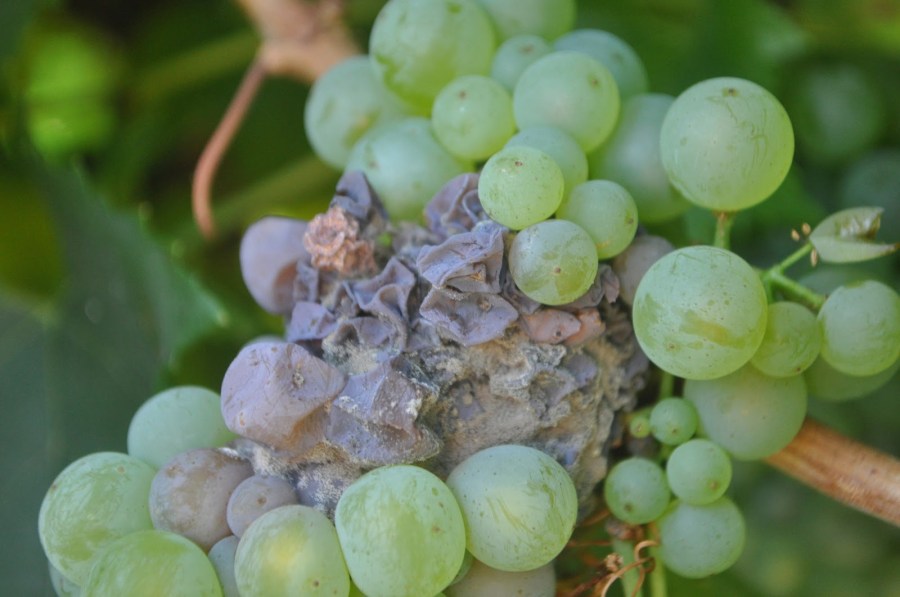Despite an unsettled summer and slightly later start to picking than last year, prospects generally still look very good for the 2023 harvest reflecting the excellent conditions during flower initiation last year.
For later-maturing cultivars, much obviously depends on the weather over coming weeks and how quickly crops ripen. Ripening can soon catch up in warm, dry conditions, but if it’s dull and wet like July and August, some growers of late-maturing varieties like Chardonnay, Seyval and Pinot Noir (late), may still be picking into late October or early November.
Botrytis pressure builds
Given the unsettled season so far, managing botrytis bunch rot risk is understandably at the forefront of many growers’ minds, and must be guarded against right up to harvest to protect both yields and juice quality.
Conditions have been ideal for botrytis this year, starting with wet weather in late June/early July, which reduced set in late-flowering cultivars and allowed latent infection to start building in some crops. This has been exacerbated by wet conditions through summer, increasing the chances of thin-skinned berries splitting and letting infection take hold.
Depending on how far the infection goes, sour rots can sometimes follow, which in turn creates conditions that attract Spotted Wing Drosophila (SWD).
Risk does vary according to cultivar, being greatest in those with tight bunches where the pressure is more likely to build up to the point where berries pressing on each other give rise to splits. Conversely, many hybrids, or those treated with growth regulators to loosen bunches, and certain clonal cultivars, have much looser clusters, which allows more room for berries to expand, resulting in less splitting and reduced botrytis risk.
Control options
A range of control options are available, but the most appropriate depends on the estimated picking date, and what has been used so far.
The main fungicides include products based on fenhexamid, pyrimethanil, and cyprodinil + fludioxonil. These can be used twice each in any one season, but given the high disease risk through the summer, many growers may have exhausted these by now.
Alternatives include products based on boscalid, or tebuconazole + trifloxystrobin, although these have 28 and 21-day harvest intervals respectively, which is likely to preclude their use on all but the very latest picked grapes.
Beyond that, the only remaining options are the less effective bicarbonate, or biological controls, such as cerevisane, and those based on naturally occurring microbes, such as Bacillus or Aureobasdium products. Bacillus products are a preventative option that work by colonising the same areas that botrytis pathogens would inhabit. Bacteria then produce anti-fungal compounds to prevent botrytis infection. With little or no harvest interval, they can be used right up to harvest, but their effectiveness is very much dependent on achieving good spray coverage and colonisation of the target area (i.e. the bunches).
Ideally, growers will have already stripped most of the leaf out of the fruiting wire area to improve ripening, which should benefit spray coverage on the bunches. Adjuvant regulations prohibit the use of silicon wetters, or Wetcit, to assist with coverage if using plant protection products at full rate, but there is the option to apply reduced rate and a bunch targeted spray plus adjuvant, or use a full rate without adjuvant still targeted on the bunches. Whichever option is chosen, coverage is key and this depends on what can be achieved with a medium to fine spray and directed application from air assisted sprayers, or controlled droplet application (CDA) nozzles.
Post-harvest feed
While the prospects for this harvest reflect the excellent conditions during flower initiation last year, unfortunately, the same cannot be said about the likely flower initiation in 2023, given the dull, wet conditions this July.
With this in mind, post-harvest foliar nutrition could be a worthwhile investment to help ensure next year’s canes and buds are as healthy as possible. There were few opportunities to do so in 2022, given early leaf senescence in an exceptionally dry year, but there may be a window to apply N,P,K and trace elements such as boron, zinc, manganese and magnesium, to earlier-harvested vines this autumn. A sustainable way of getting nitrogen into the leaf is using R-Leaf, which captures nitrous oxides from air and converts them to nitrate.
Even though a large amount of material is removed during winter pruning, applying foliar nutrition before leaves start to senesce, or the first frost, has proven to be a useful way of getting vital nutrients into buds, resulting in bold, hardy buds to select from for next year. Hopefully this will translate into good flower production next spring. The alternative is not to feed, which, after a season such as this, usually results in weaker flowering and possibly poor fruit set.




